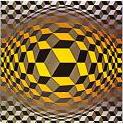Victor Vasarely by Magdalene Holzhey
Published in paperback by Taschen, London 2005 (ISBN 3-8228-3908-6)
Reviewed by Marianna Cage
How does one create an image that speaks of the universality of man and mind? By what means can that art be accessible to all, reproducible and democratic? When Vasarely was painting this vision was a shared reality hindered only by technological progress. Now humankind has the technology, but do we have the vision?

The synthetic totality tends towards the iconographic and marginal. The surreal juxtaposition of unconnected images tends towards the obscure, the evanescent and the fleeting. The landscape lures us with promises of greener grass, but leaves us homesick and spiteful. The portrait orders reminders of obligations past and the picturesque exudes aromas of never ready apple pies. In each something is lacking. Totality is rarely simple and never pure. Totality cannot be captured by representation. Totality is eschatology with disappointment as its end.
Although the geometric abstraction is haunted by these styles it is beholden to neither. Line and colour form time and space. The exterior is internalised and this constant motion draws the surface environment into its timeless depths. Vasarely sought to re-direct art back to a relationship with its origin, the everyday. The image does not represent, but facilitates, it does not reflect but opens doors to different worlds.
Vasarely points us towards totality not because his kinetic geometry is a physics, but because the visual narcosis induced by his work is a metaphysics: found somewhere between the sensible and insensible, the intelligible and the unfathomable, the measurable and the immeasurable. That is to say it is a visual metaphysics founded on the tectonic borders of reason and abandon.
At what price does this effort come? The cost is the loss of the message in the image. The image is all effect, the information cannot be de-coded, because it conveys no information that is not brought to it by the viewer.
The art requires the intelligence and experience of viewer without whose eye they are empty universals, but with whose participation the vast richness of nature unfolds. These images are stronger than words, choosing to write about Vasarely is to leave oneself bereft, forlorn, and estranged. Only in feeling do the word and the visual connect.
